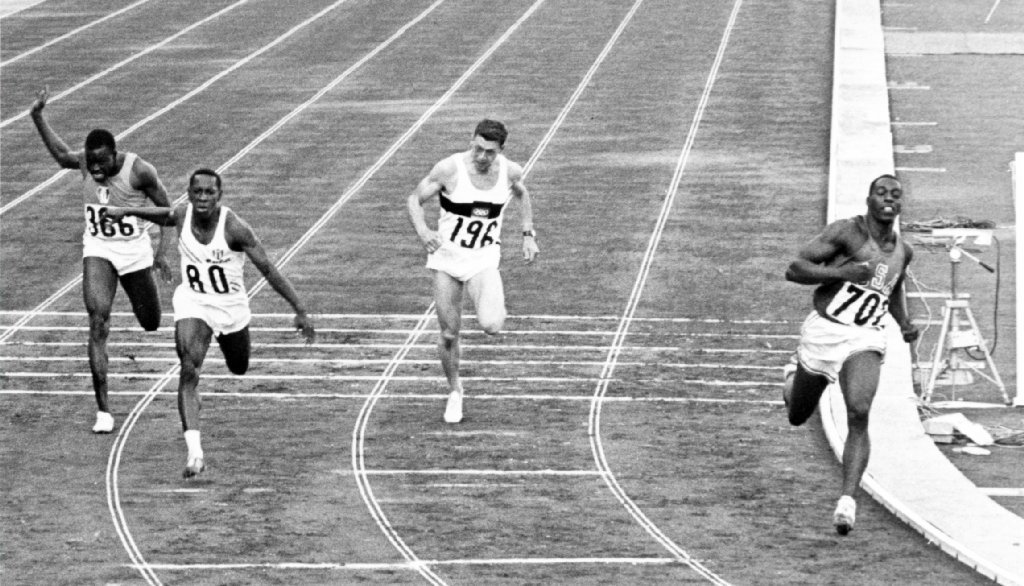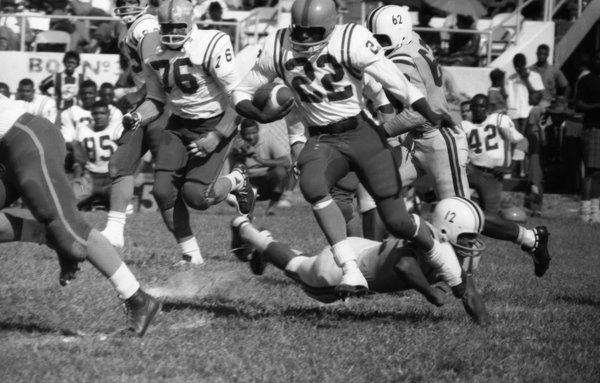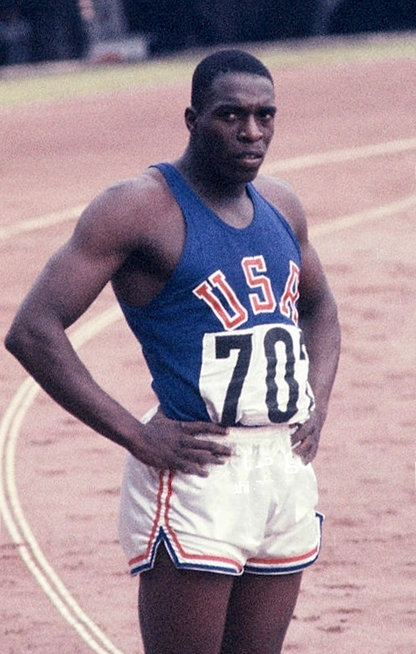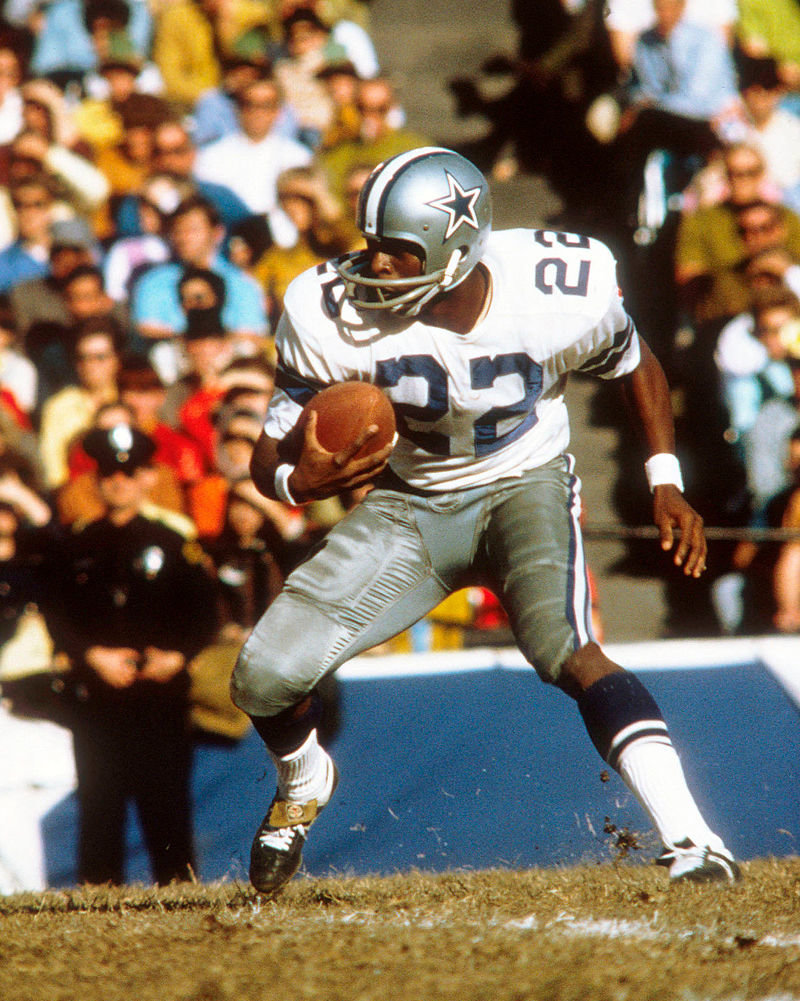Jacksonville’s Superman ‘Bullet’ Bob Hayes, the world’s fastest human
On Oct. 15, 1964, Robert Lee Hayes of Jacksonville hunched over his starting blocks in Tokyo, at the Olympic games, methodically pounding the spikes that would hold those blocks in place into the cinder track with a large rubber hammer. He was twenty-years-old and wearing sunglasses. He looked cool. Hayes, known as “Bullet Bob,” was a favorite to take home an Olympic Medal, but there were complications.
Despite protests from the U.S. Team, Hayes had been assigned the inner lane. That lane was torn up and pitted from a long-distance walking race the day before. Hayes was also running in borrowed shoes. “Smoking Joe” Frazier had lost one of Hayes’ cleats back at the Olympic Village. Frazier would win a gold medal in boxing in Tokyo and then go on to an epic rivalry with 1960 Gold Medalist, Muhammad Ali.
Bob Hayes coolly stared down the Olympic track, his whole body coiled like a spring as he awaited the gun and a furious 10 seconds of churning knees and elbows that would answer forever the question pondered by Sports Illustrated, “How Fast is Bob Hayes?” Was he really, “the fastest man who ever lived,” as his college football coach claimed?
Bob Hayes’ speed was something of a well-kept secret prior to 1964. His blazingly fast times in the 100-yard dash at Matthew W. Gilbert High School in Jacksonville (now Raines H.S.), went largely unnoticed. The state record was held by two brothers at the all-white Robert E. Lee High School on the other side of town. The brothers ran times of 9.9 seconds. Hayes’ time of 9.5 did not count.
He was Black.
Hayes grew up in the segregated South racing other children of color for nickels. Childhood friends called him the “shortest distant between two points.” He was also a football player. In 1957, he played for a Matthew W. Gilbert High School football team that won a “Black” state championship. Many experts consider the ’57 Gilbert High School team to be one of the best this state has ever produced.
After high school, Hayes matriculated at Florida A&M to play football for legendary football coach, Jake Gaither. It was said that Gaither liked his athletes “agile, mobile and hostile.” The 6-foot-tall, 190-pound Hayes, fit that bill. Florida A&M was founded as the State Normal School for Colored Students. It was built on the plantation of a former governor, near Tallahassee. Hayes’ career there almost ended before it started. He and a classmate were accused of stealing 11 cents and two sticks of gum from another student. They had purportedly used a water gun but were still charged with armed robbery. Hayes spent seven days in jail. Only coach Gaither’s fervent pleas before the judge kept young Bob out of prison.
“Bullet Bob” Hayes rewarded his coach’s faith. The Rattlers only lost four games in three seasons. A&M won two Orange Blossom Classics during his career. The Orange Blossom Classic, played annually in Miami, was the unofficial “Black National Championship.”
In 1964, the Tokyo Olympics were held in October, the middle of the football season. Hayes was needed on the gridiron. He was also needed at the Olympics. President Lyndon Baines Johnson was concerned Hayes might get injured playing football. LBJ called coach Gaither to express those concerns. Gaither reluctantly agreed to give his star time off from football to train. He called Hayes into his office and told him, “You can go run in the Olympics, but you’re going to have to earn your spot when you get back.”
During his college track career, Bob Hayes of Jacksonville mostly ran in segregated events against other Black colleges. He ran stunningly fast times, but could those times be trusted? “Bullet Bob” first gained national recognition in Miami in 1962. In a move that shocked and angered many whites, the University of Miami invited Hayes to participate in the 100-yard dash at its annual track meet. Hayes won. He tied the U.S. record of 9.2 seconds. He was elated. It was his first official record. His teammates were proud. Coach Gaither was mad. “I sent you down there to break the record,” he chided his prodigy, “Not to tie it.”
Back in Tokyo, at the Olympic finals, Hayes dug in and eyed the finish line and his destiny 100-meters away. He knew he was fast. Now, it was time to show the world just how fast. The last thought to cross his mind before the gun sounded was “I’ve got to win this race.” He got out the blocks quickly and as he stormed down the track, he kept gaining speed, running away from the field and winning by over two meters. That is the largest margin of victory in an Olympics, ever. His time of 10 seconds broke the Olympic record. It is still the fastest time ever run on an Olympic cinder track. He was the World’s Fastest Man.
The Bullet saved his greatest heroics for the 4x100 relay. When Hayes took the baton for the final leg of the race, the USA stood in fifth place, seven meters behind the leading French. Thirty meters into the race, “Bullet Bob” ran past everyone. It is, to this day, the fastest leg of a 100-meter relay ever run at 8.6 seconds. The New York Times called his phenomenal come-from-behind finish,“the most memorable 100-meters in track and field history.” Before the race, a French runner had taunted one of the Americans. “You cannot win,” he declared. “All you have is Hayes.” After the race, the jubilant runner sought out the brash Frenchman and retorted, “That’s all we need, baby!”
After the Olympics, Hayes won his spot back on the Rattlers and helped lead the team to that second Orange Blossom Classic. In January of 1965, he became one of the first Black players to play in the Senior Bowl. Late in the game, with the South trailing 7-0, Hayes caught a 56-yard pass from Alabama quarterback and future Super Bowl legend Joe Namath that tied the game for good.
Bob Hayes, the football player, was drafted by the Dallas Cowboys. He led the league in touchdown catches each of his first two seasons and changed the way the game was played! Double coverage and zone defenses were invented in an attempt to contain the speedy receiver. No one could cover the Bullet on their own. Teammate Roger Staubach once declared that “no one, unless they saw Bob run, can fathom how fast this guy was … if he had one step on a defensive back, it was all over. There was no hope.”
In 1971, when the Cowboys won the Super Bowl, Hayes became the only man in history to win both an Olympic gold medal and a Super Bowl ring. That is some pretty heavy hardware! Bob Hayes, the man his football coach at FAMU once described as “the fastest man who ever lived,” was finally elected to the Football Hall of Fame in 2009, seven years after his death and almost 35 years after his record-setting career ended.
After his football career ended, Hayes tragically descended into alcoholism and drug abuse. In 1979, he got caught up in a sting operation in Dallas. He ended up being convicted for delivering cocaine to an undercover officer. He served 10 months of a five-year sentence for trafficking. The sentence was harsh. It was Hayes’ second offense. He was still on probation for “armed robbery” for stealing that change and sticks of gum in Florida, back in 1961.
It bothered Hayes that the doors to the Football Hall of Fame seemed closed to him, but he was used to being snubbed. He grew up in a world where his times did not count. Where he did not count. When he came home from the ’64 Olympics a parade was planned in his honor by African-American civic leaders. The parade would pass through downtown under the shadow of the Confederate statue that once dominated Hemming Park.
Initially, the Times-Union refused to cover the event, because he was Black. At the last second, a young female reporter named Jessie-Lynne Kerr was insistent she be allowed to cover the event. “I don’t care if Hayes is Black, white, or purple with orange spots,” she brazenly told her editor. “I don’t know of anyone else coming home to Jacksonville with two gold Olympic medals.” The picture of Bob Hayes in the paper the next day marked virtually the first time an African American had been featured in that publication who was not under arrest.
Late in life, Hayes returned to Jacksonville to live with his parents, a broken man. His fall from grace had been precipitous. After prison, he found God and got sober, but the damage to his body had already been done. In 2001, he died of kidney failure, at the age of 59.
Bullet Bob Hayes is Jacksonville’s Superman, faster than a speeding bullet and possibly the fastest man who ever lived. Some people think that if you put Hayes and Usain Bolt on the same track, with the same equipment, at the same age, Hayes would win.
Scott A. Grant is an author, historian, and asset manager based in Ponte Vedra Beach, Florida. He welcomes your comments at scottg@standfastic.com














